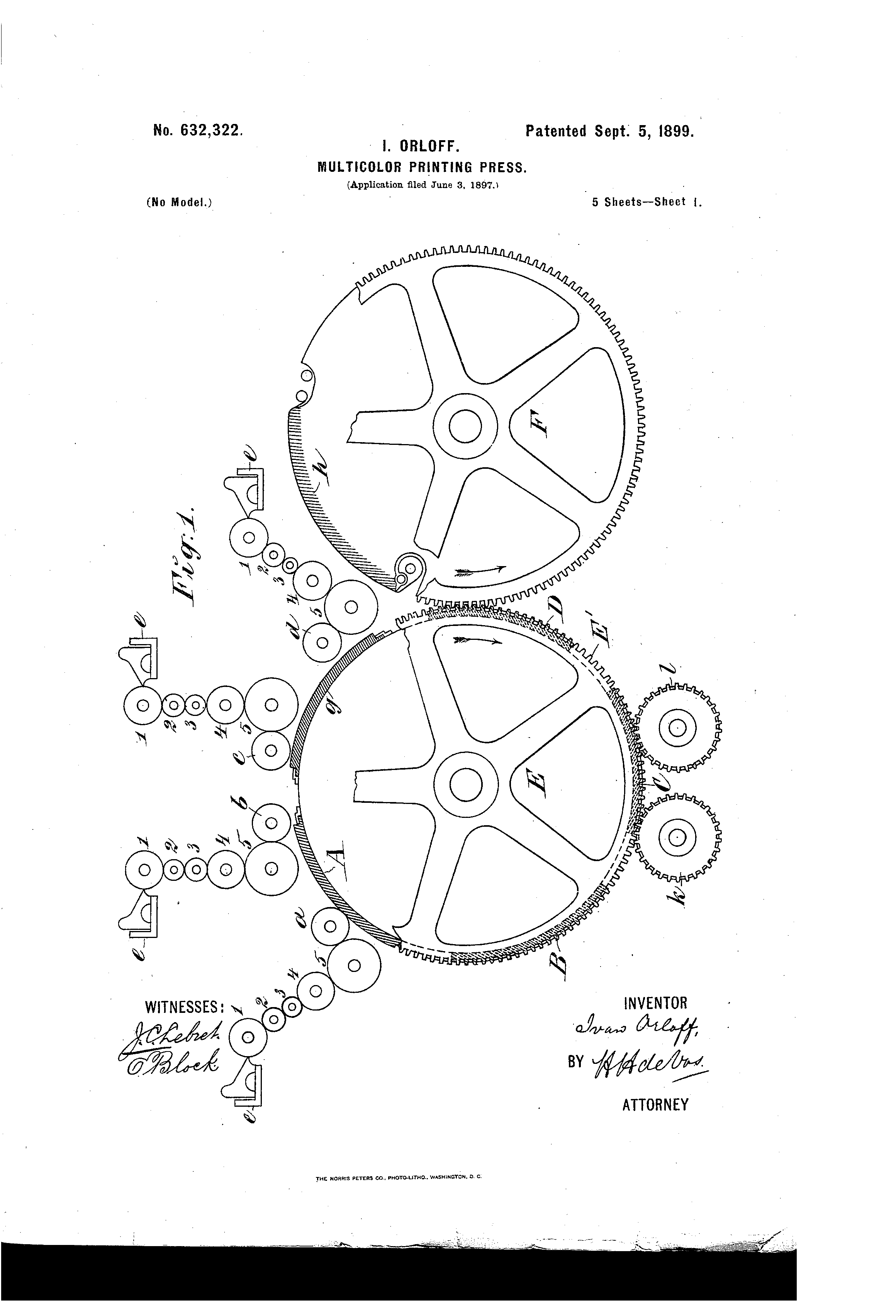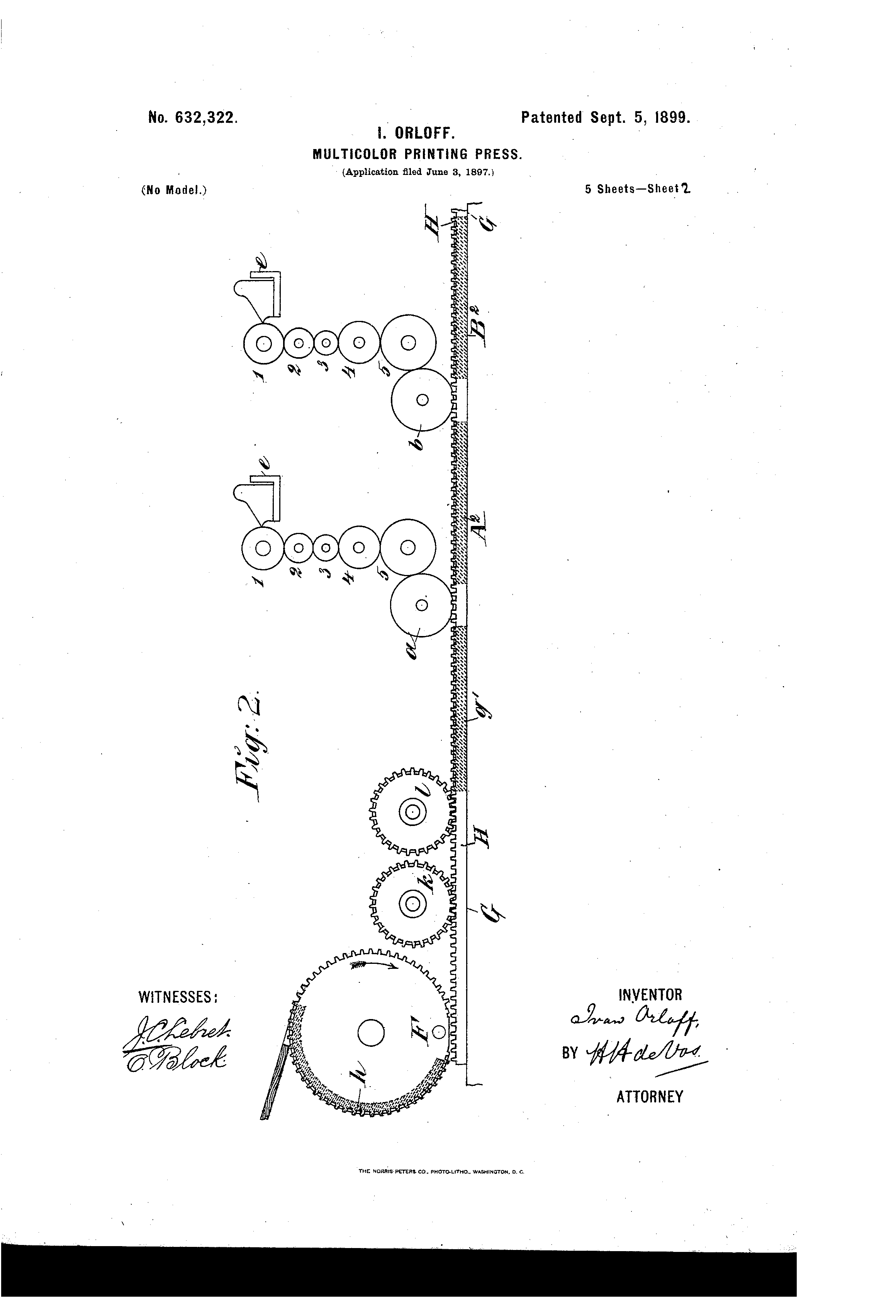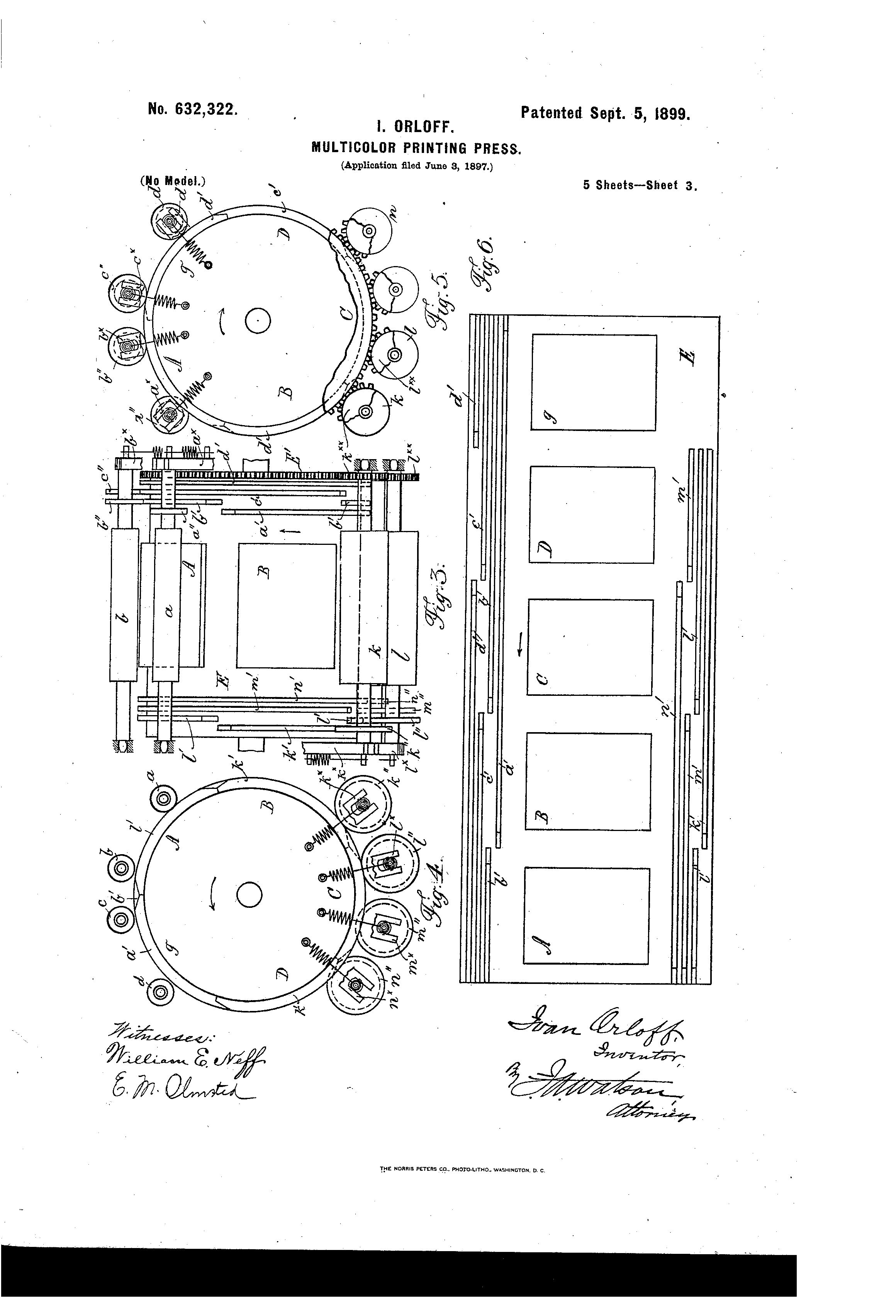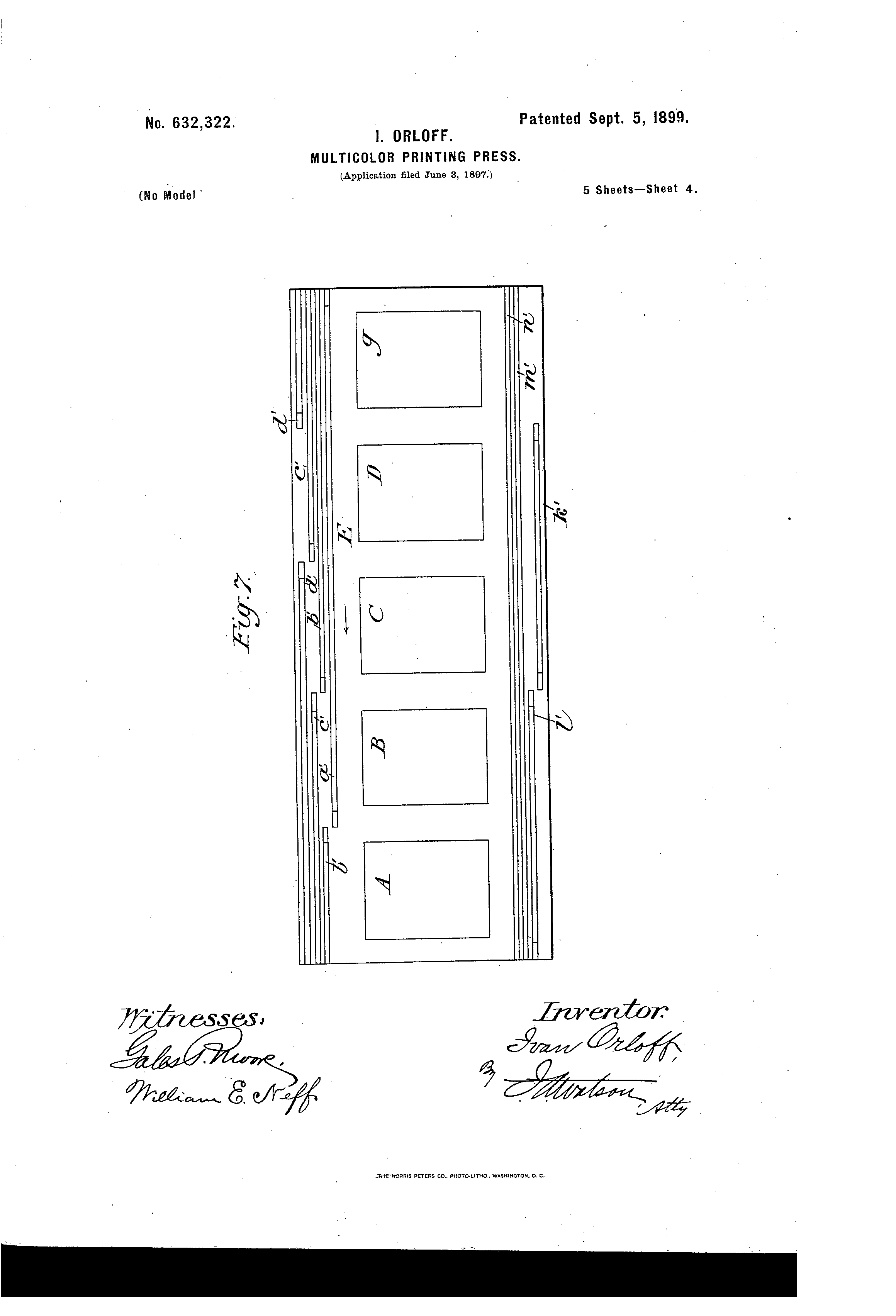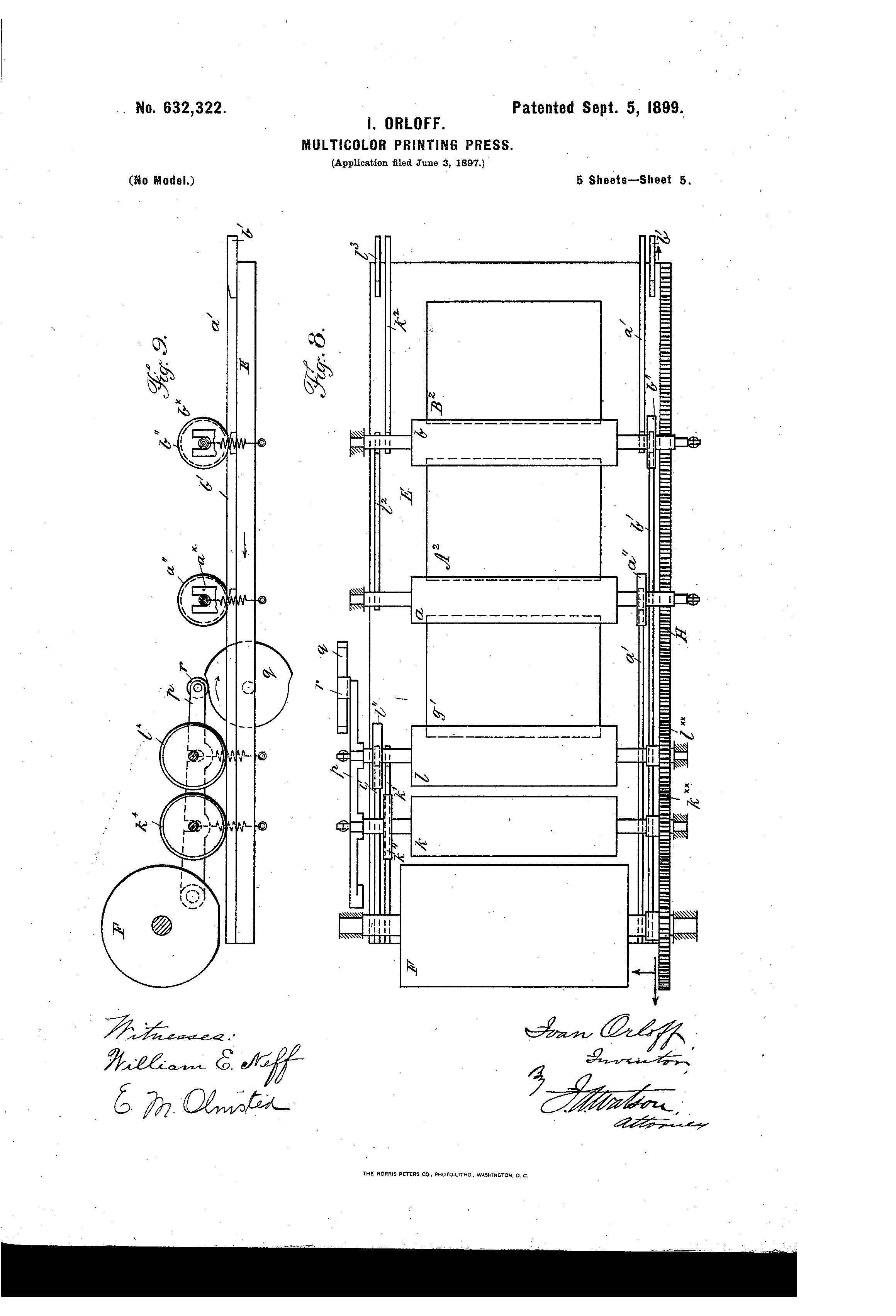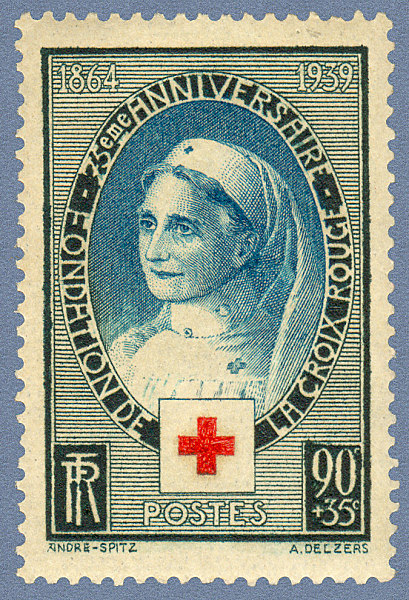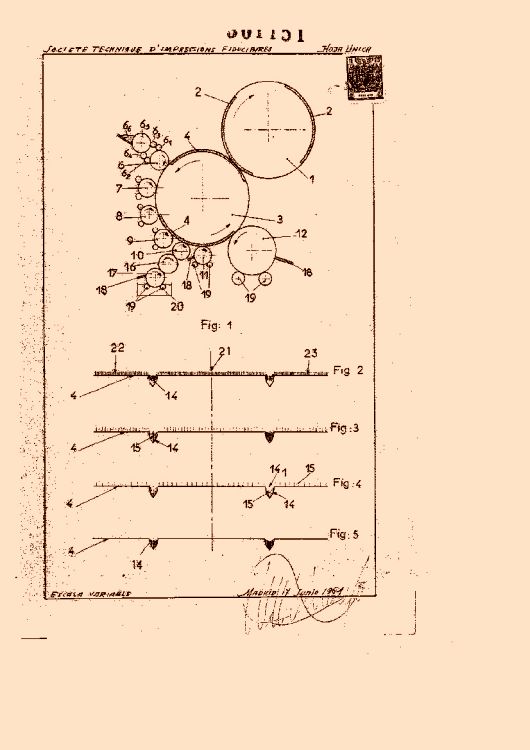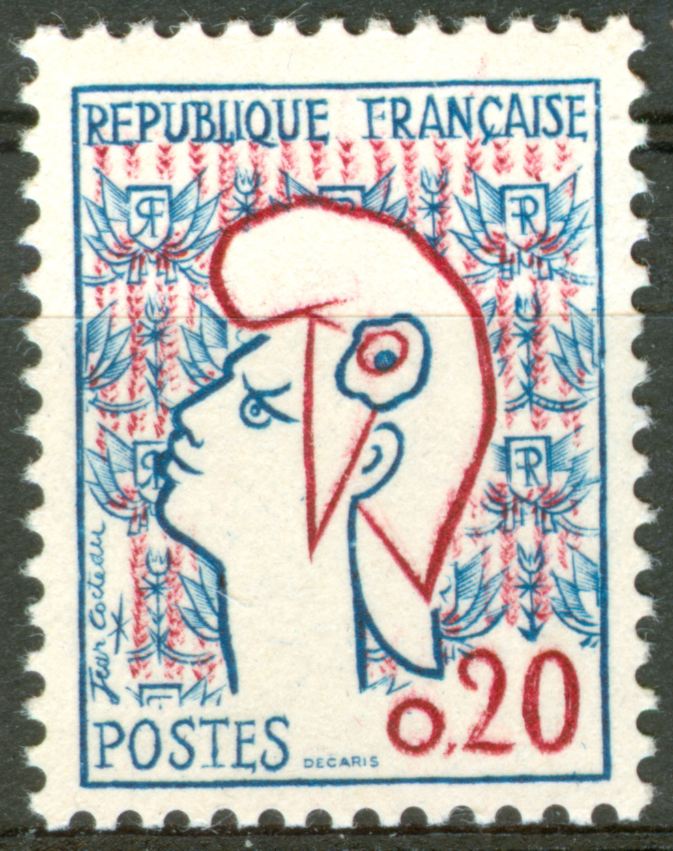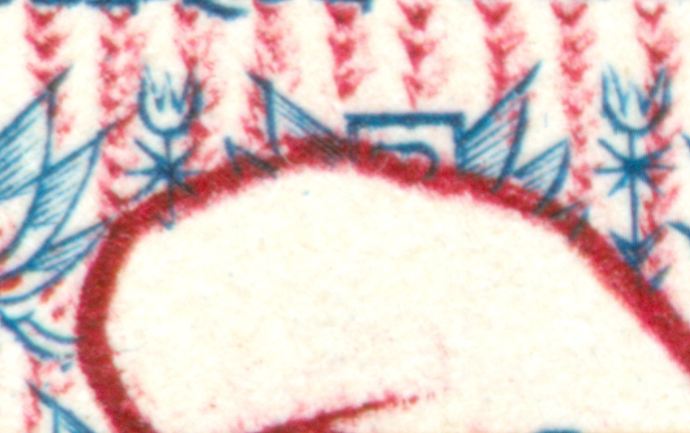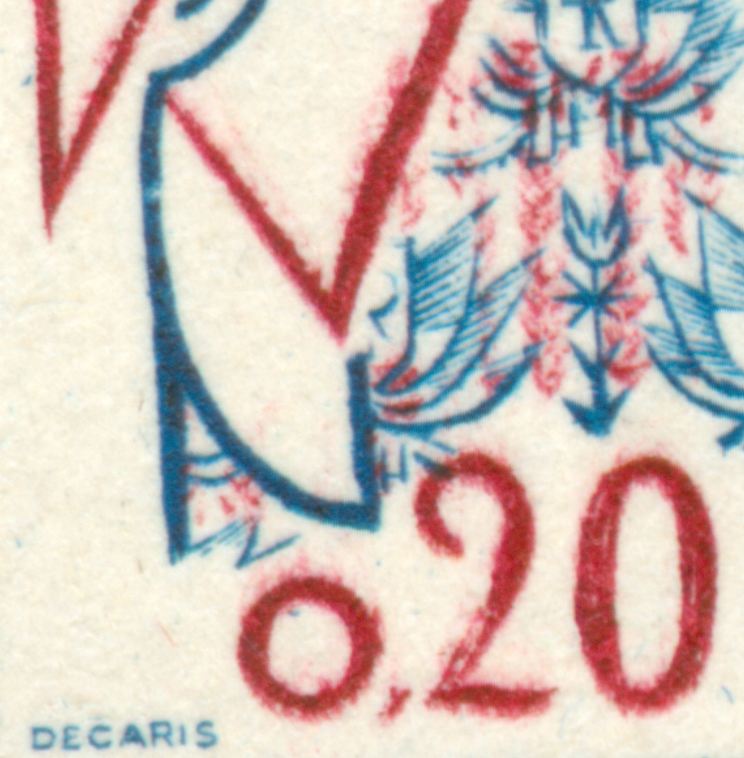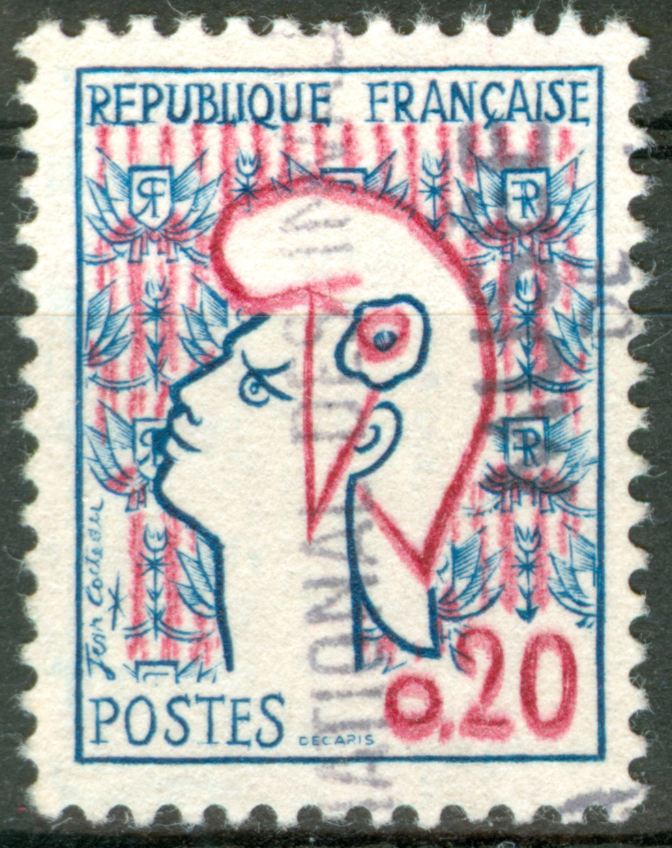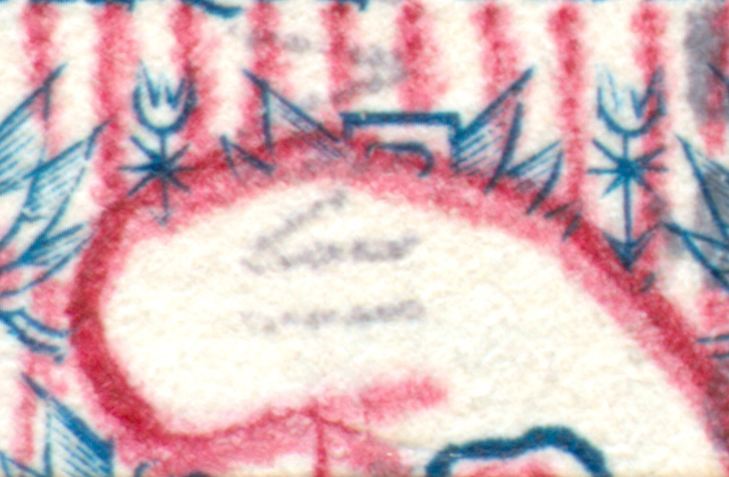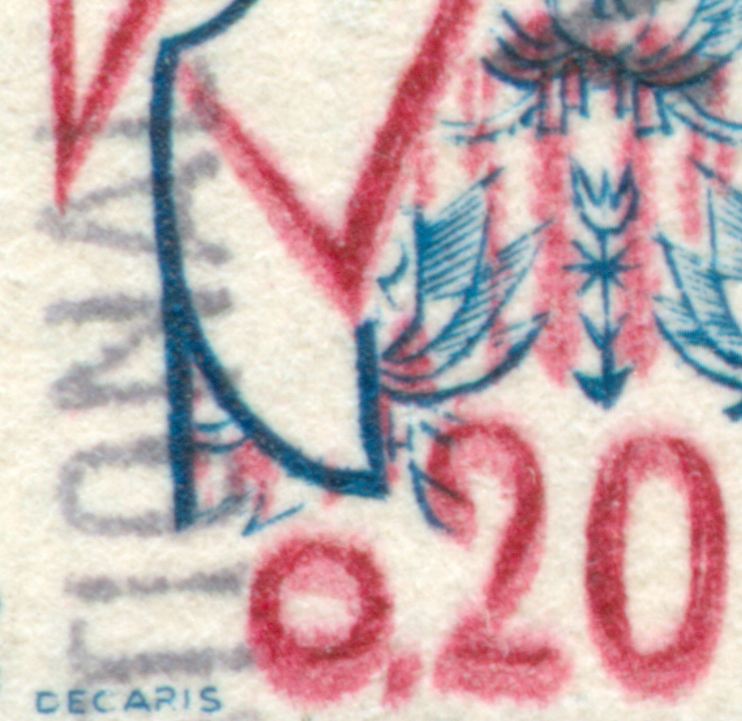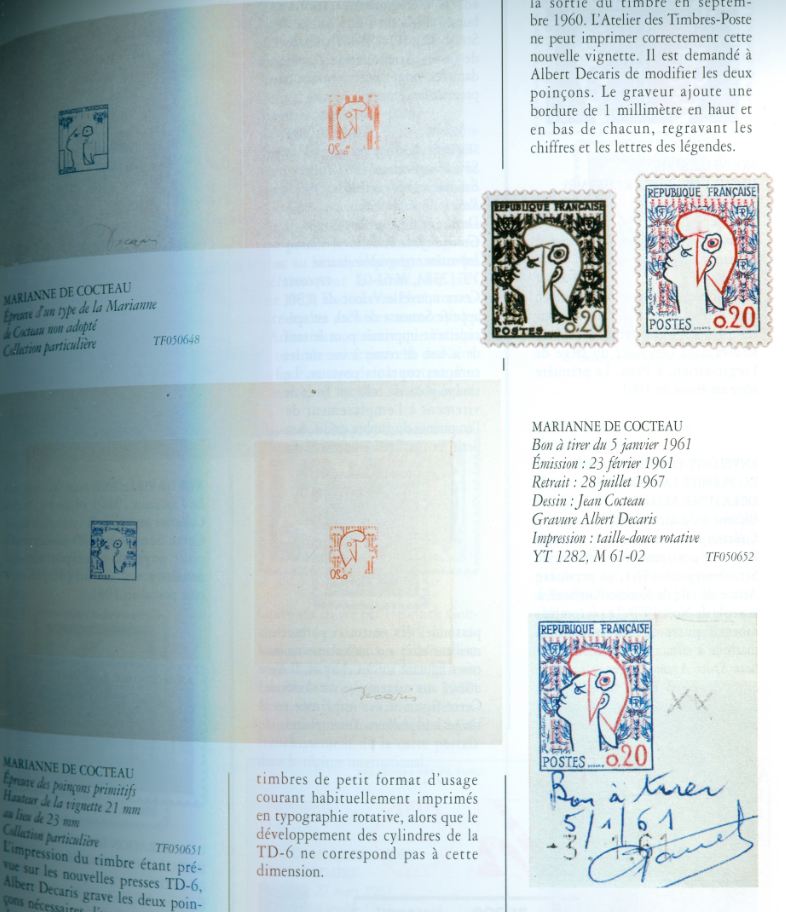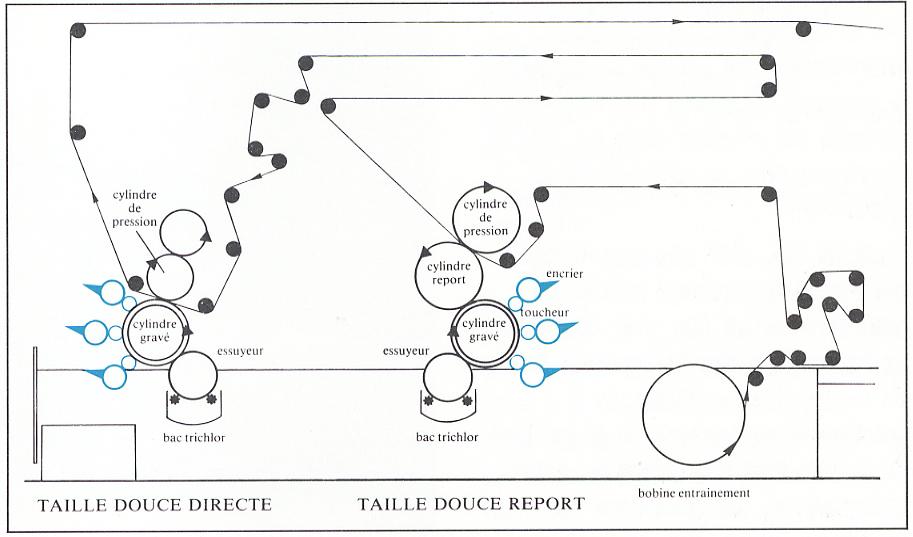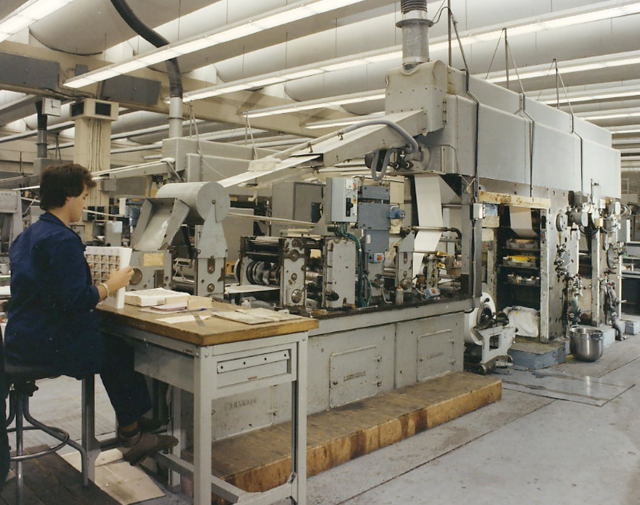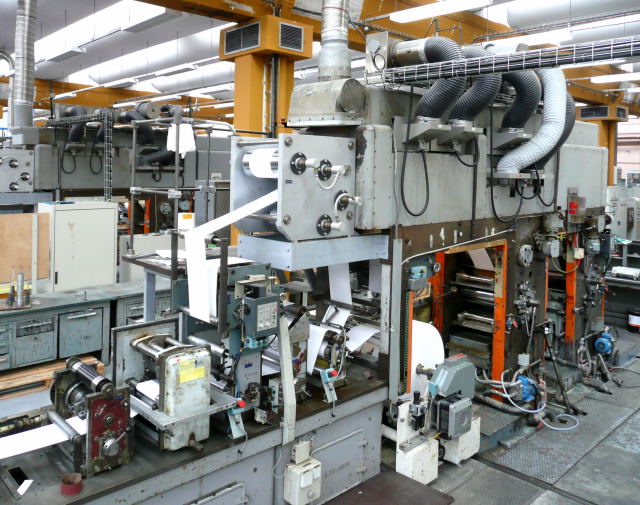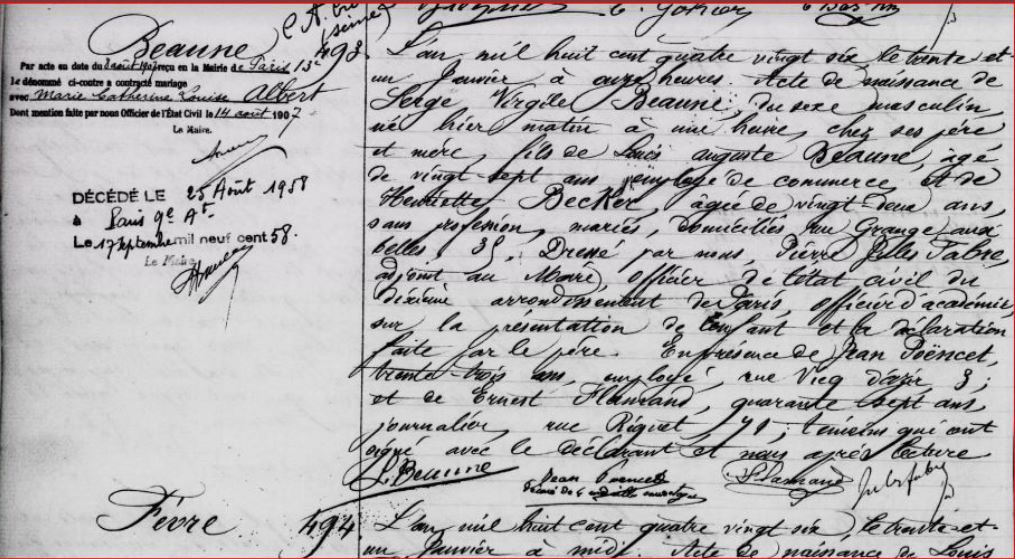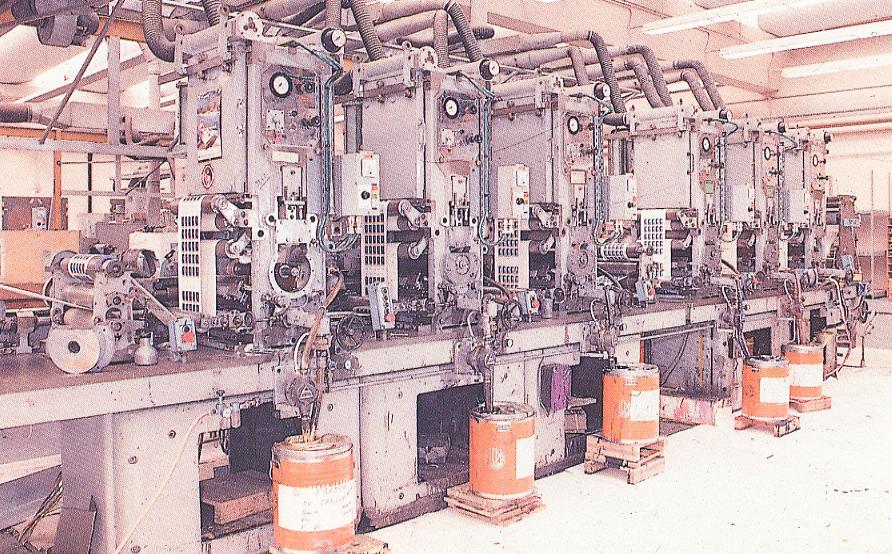Beaune
Application of Serge Virgile Beaune, Deceased, by Catherine
Louise Albert Beaune, Roberte Louise Beaune, Guy Joseph Beaune and
Daniel Charles Beaune, Legal Successor and Heirs, 363 F.2d 893
(C.C.P.A. 1966)
Annotate this Case U.S. Court of Customs and Patent Appeals
(1909-1982) - 363 F.2d 893 (C.C.P.A. 1966)
July 28, 1966
John E. Lind, Washington, D. C., for appellants.
J. Schimmel, Washington, D. C. (Fred W. Sherling, Washington, D.
C., of counsel), for Commissioner of Patents. Before RICH, Acting
Chief Judge, MARTIN, SMITH, and ALMOND, Judges, and Judge WILLIAM H.
KIRKPATRICK.* SMITH, Judge.
The issue is whether the invention, a process, defined in the
single claim1 on appeal is obvious under the terms of 35 U.S.C. § 103.
The claim is as follows:
4. Process for the impression of multiple colors upon supports
such as fiduciary papers starting from several engraved polychrome
elements, comprising forming for each element an engraved copper plate
reproducing the motif relative to each element, then forming for each
element a plate called the impression plate comprising the motif of
relative colors for the corresponding element and differing from the
motif to be reproduced, transferring the motif of the impression plate
upon inking rollers, cutting each of said inking rollers in order to
allow to remain in relief only the motif relative to the color
assigned to said roller, inking one of said rollers with a fundamental
color, inking each of the other rollers with an altered or derivative
color of the fundamental color, inking one of the engraved plates
successively with each of said rollers, then wiping said plate so that
only the engraved lines contain the ink attributed to such lines,
doing the same operation for the other engraved plates by attributing
to each of said plates a different fundamental color and colors
altered or derivatives of said different fundamental color,
superposing successively upon said support each of the engraved plates
so inked while using for each of the transfers upon said support
except the last a cylinder having a blanket to transfer the ink
attributed to the engraved lines of each plate with a very slight
pressure without deforming said support, and then effecting the last
transfer directly of the engraved plate upon the support by a cylinder
having a blanket pressing the support upon the engraved plate to
transfer the ink attributed to the engraved lines with a pressure
causing simultaneously a deformation of said support.
The prior art references relied on are as follows:
Lee 282,995 Aug. 14, 1883 Schultz et al. 1,379,365 May 24, 1921
Yetter 1,581,151 Apr. 20, 1926 Lohmann 2,085,435 June 29, 1937 Lathey
2,303,646 Dec. 1, 1942 British patent 610,943 Oct. 22, 1948
Appellants< invention will be considered first. It concerns a
process for the impression of multiple colors on paper from several
engraved elements. The embodiment described in the application and
discussed in the briefs relates to three engraved elements. Each of
the three engraved elements, mounted on rolls, operates successively
on the paper and receives ink from sets of three mutually exclusive
inkers. Each engraved element thus receives three inks, a fundamental
color and two derivatives of that color. Concerning the first two
engraved elements, the ink deposited on the engraved element is
transferred to the paper via a roll covered with a blanket of plastic
material with slight pressure. In the third or last printing the ink
on the engraved element is deposited directly on the paper. A roll
exerts pressure directly on the paper as it passes over the third
engraved element causing deformation of the paper.
Appellants comment in their brief on the invention as follows:
* * * the first transfers or printings are made with a very slight
pressure and as they are small in number (two in the example cited in
the application) the deformation of the paper is zero and consequently
the registration can be exact which permits documents whose production
is simple and highly protected against counterfeiting. The transfer of
the last printing element is carried out under pressure in order to
obtain deformation which modifies the general design and makes more
difficult still the counterfeiting of the document.
In addition to the above feature of the invention the invention
also comprises a combination of the following:
1. The superpositioning upon a paper of copper plate engraved
elements, each inked with a fundamental color and colors derived or
obtained from the fundamental color.
2. The inking of each element by inking rollers carrying in relief
the color motif attributed to such roller (the fundamental color or
the derived or faded color).
3. The constitution of the motif of the colors of the printing
rollers starting from a plate called the impression plate comprising
the complete motif of color, this complete motif being transferred
upon each of said rollers which are then engraved in such a manner so
as only to allow in relief the motif of the color assigned to such
roller.
Claim 4 was rejected as unpatentable over Schultz et al. in view
of the teachings of Lathey and British. Lee was cited only to show
that plate printing wherein the ink is transferred directly from the
engraved plate to the paper takes place under heavy pressure between
the printing plate and the impression cylinder. Lohmann was cited to
show that the pressure between the intaglio type die and the resilient
impression cylinder is such as to emboss the paper. Yetter was relied
on only to show it to be conventional to use different colors or
shades and times [sic, tints] of a single color in intaglio printing.
The board in its opinion adopted the following reasoning of the
examiner:
The British patent teaches the technique recited in lines 3 to 11
for making cut out inking rollers and indicates that they are to be
used for inking intaglio plates with several colors * * Lathey has a
clearer showing of inking intaglio plates with cut out inking rollers
and then wiping to leave the ink only in the engraved lines. Having
the colors of the inks as fundamental (or primary) and altered or
derivative colors, as called for in this claim, is the use of shades
and times [sic, tints] of a color, in different inks, and a matter of
choice in the art, as in Yetter, for example. Schultz et al. disclose
multicolor printing wherein the last ink impression is made directly
upon the paper by an intaglio printing plate and the preceding ones
are made indirectly, by using a blanket to transfer the ink from the
printing plates to the paper. This reference also indicates that
intaglio printing plates may be used for these preceding impressions.
It is not seen to be unobvious to one skilled in the art to have all
the printing plates on the cylinders * * * of Schultz et al. as
intaglio plates, to ink each of these plates with several inks, as
taught by Lathey and the British patent, using inking rollers made as
shown in the British patent. Having the last, direct impression made
with heavy pressure, so as to deform or emboss the paper is common in
the art, as exemplified by Lee or Lohmann, and is not considered to
make the claim patentable over the references. The board added the
following comments in affirming the examiner's rejection:
While Schultz et al. appears to apply the preliminary printings *
* * simultaneously to the paper * * * through the common impression
roller * * * and not successively as called for in the claim, we do
not believe that successive application of the printings would exceed
routine choice or skill of persons having ordinary skill in the art.
We stress also that a reading of the Schultz et al. specification has
left no doubt in our minds that the preliminary printing by roller * *
* does not deform the paper and that the intaglio roller * * * does
deform it, which is in effect the inventive concept urged as
patentable in the instant application. It is appellants< position here
that the examiner and board interpreted every reference correctly save
one, the patent to Schultz.
Appellants argue:
The present application presents a new and novel feature according
to which the transfer of ink contained in the lines of the last
engraved plate is assured by a cylinder * * * covered with a hard
blanket allowing the transfer of the ink under a pressure so that the
support paper is deformed.
The first transfers are carried out under the slightest pressure
possible in such a way as not to deform the support paper while
preserving all the suitable characteristics of the copper engraving
process.
This feature is not found in Schultz et al. where there is no
deformation of the support paper during the last ink transfer.
* * * * * *
The other patents relied upon by the Examiner and the Board of
Appeals show only a single step of the combination claimed and to
combine these various steps in one process as called for in the claim
on Appeal involves invention, particularly when the valuable results
accomplished are viewed.
We shall first determine, as a factual matter, what Schultz fairly
teaches before proceeding to the issue under section 103. In re Chupa,
359 F.2d 908, 53 CCPA ___.
Schultz discloses a method and apparatus for making multicolor
prints. Three printing rolls and an intaglio impression cylinder
cooperate with a main impression cylinder. They are located at 90°
intervals about the periphery of the main cylinder. A second intaglio
impression cylinder cooperates with the first intaglio cylinder. The
paper to be printed passes between the first intaglio cylinder and the
main cylinder and then between the two intaglio cylinders. The three
printing rolls transfer successively yellow, red and blue color inks
to the same surface area of the main cylinder. Planographic (surface
printing) plates are preferred for the printing rolls over intaglio
(relief printing) plates. The second intaglio cylinder prints black
ink directly on the paper after the color ink has been transferred
from the main cylinder to the paper.
Both intaglio cylinders are mounted on eccentrics in order that
they may be moved in and out of contact. As the surface area of the
main cylinder carrying the ink approaches the point of contact between
the first intaglio cylinder and the main cylinder the essentric
operates to throw the intaglio cylinder into impression contact.
Similarly, as the color printed portion of the paper approaches the
point of contact between the two intaglio cylinders, the eccentric of
the second cylinder operates to throw the cylinders into impression
contact with the consequence that,
* * * a roto-gravure print will be superimposed upon the
impression carried by the paper and thereby those portions of the
original copy which corresponds to the shades will be received from
said intaglio cylinder.
Schultz discloses the following advantages:
Our invention, which is applicable alike to the printing on paper
or textile, renders it possible to produce on continuous web-presses
even more faithful reproductions than is obtained by laborious offset
lithographic processes when employing as many as six colors. Further
advantages are the virtual elimination, owing to the register being
positive throughout, of register difficulties such as are experienced
in ordinary offset color printing wherein the sheet travels over
numerous cylinders during the application of the color thereto and the
reduction to a minimum of the possibility of blurs occurring due to
stretching of the large blankets employed in most offset color
printing. Besides the latter advantage in respect to minimizing blurs,
the small sections of blanket used are far easier and more economical
to replace when soiled or worn than are the large blankets usually
employed in such work.
* * * * * *
While offset printing has certain advantages in that the yielding
blanket compensates for irregularities in the paper, as distinguished
from direct printing wherein an unyielding metal plate is in contact
with the paper, thus enabling one to reproduce delicate shades very
faithfully, nevertheless, one of the objections to the offset printing
is the fact that one cannot produce the key color varying from the
intense depths up to the finest gradations of tones as is possible
when a direct intaglio print in the key color is superimposed in the
manner herein described. Accordingly, our process while, enabling one
to utilize the advantages of the intaglio for the key color and thus
obtain all gradations of color from the intense depths to the softest
tones, at the same time preserves all the advantages of offset
printing including that of the relatively cheap cost of same.
Appellants argue that Schultz does not disclose a last transfer
step under pressure. Their brief states:
Particular attention is invited to the term roto-gravure in the
above. Actually a roto-gravure is a process of photogravure in which
the impression is produced by etched cylindrical plates affixed to the
rollers of a rotary printing press; hence, an illustration so printed.
It is well know in the art that such a printing is not done under
pressure so as to produce embossing. The claim on Appeal, however,
calls for several transfers with slight pressure and the last transfer
is effected with strong pressure so as to secure the embossing effect.
* * * * * *
The last transfer under pressure allows a simultaneous deformation
of the support in order to emboss and render the document more
difficult to reproduce. The transfers that are made in Schultz et al.
are made without deformation of the support and in an entirely
different manner.
* * * * * *
The pressures to be exerted upon the support are totally different
and the effects obtained can not be compared. The solicitor in his
brief does not support the board's conclusion, quoted supra, that the
second intaglio cylinder in Schultz deforms the paper and the first
does not. His argument is as follows:
* * * the question to be decided is not only whether the roller *
* * [second intaglio cylinder] does deform the paper but also whether
it would be obvious to have the roller * * * deform or emboss the
paper. Schultz et al. do not state whether the roller * * * deforms
the paper, but it does certainly appear that the direct pressure
contact of the engraved roller with the paper as disclosed by Schultz
et al. would deform the paper surface to some extent. Moreover, it is
common in the printing art to deform or emboss a paper with an
engraved roller as shown by Lohmann * * * Therefore, it would be
clearly obvious to regulate the pressure contact of the engraved
roller with the paper in Schultz et al. to control deformation of the
paper as desired.
* * * Lohmann shows the embossing feature. Appellant acknowledges
the disclosure of Lohmann and argues that the reference only shows a
single transfer * * * but appellant's embossing step is also only a
single transfer. * * *
We think that the solicitor's comment that Schultz does not
disclose that the second intaglio cylinder embosses the paper is
correct and thus appellants have the better of the argument in this
respect. However, the fact that Schultz does not disclose embossing is
not dispositive of the issue whether the claimed subject matter is
obvious in view of all of the teachings of the prior art of record.
Turning to the section 103 issue, appellants concede that all of the
steps of the process are old in the art. The patentability of the
process allegedly resides in combining these various steps in one
process * * * particularly when the valuable results accomplished are
viewed. However, appellants did not introduce any evidence for
consideration showing facts tending to prove that valuable results are
achieved. Accordingly, the valuable results alleged are limited to
appellants< allegations that counterfeiting is made more difficult by
employing the claimed process. Appellants< brief states:
Finally, a document is obtained whose forgery is impossible, on
the one hand, owing to the complexity of the design, the superimposing
of several engravings, the large number of colors utilized, and the
changing of colors in the lines of each plate, and on the other hand,
because during the successive printings, the document remains exactly
identical with itself, i. e., that the divergences between printings
of the documents are absolutely minimum, and finally, by the embossing
given at the last transfer which takes place under pressure. Finally,
all the elements of the process help to make the forgery of the
document more difficult, both because it enables the superimposing of
several etched engravings, because the distribution of the colors is
complex, and because the printings remain identical with themselves,
while effecting the deformation of the support paper by the direct
copper-plate engraving.
Lathey and British both state that multicolor intaglio printing
makes forgery or counterfeiting of bank notes or other fiduciary
papers more difficult. Schultz teaches that positive registry
throughout and direct intaglio printing in the key color enables
reproduction of delicate shades very faithfully, as quoted supra.
As we view the references, the advantages of each step of the
process are taught by the references excepting the final embossing
step as an operation to make forgery more difficult. Lohmann discloses
an embossing and intaglio printing step which occur simultaneously as
appellants< does. However, Lohmann contemplates that his device is
useful for making seals. The specification states:
Commonly, seals and the like are printed upon a continuous web of
sheet material from which they are cut. Usually a seal press includes
a reciprocating die which cuts the printed seal from the web, the web
moving forwardly intermittently between successive cuts by the
reciprocating die. The cutting die may include an embossing die so
that the cutting and embossing are simultaneous operations. Such
presses are bulky and slow in operation and it is an object of this
invention to manufacture such articles continuously and economically
and to provide a machine for carrying out the manufacture which is
continuous in operation and economical to manufacture and operate.
* * * * * *
* * * The printing mechanism is of the intaglio type for effecting
raised printing and consists of a recessed die which is opposed by a
resilient roll. * * *
In view of the teachings of record, we believe it was incumbent
upon appellants to establish, through factual proofs, the alleged
valuable results made possible by the claimed invention. Absent such
evidence and any further argument demonstrating that the claimed
subject matter is unobvious in view of the prior art, the board's
decision must be affirmed. Each of the steps of the process argued by
appellants to make forgery and counterfeiting more difficult is
suggested by the prior art.
Affirmed.
* United States Senior District Judge for the Eastern District of
Pennsylvania, designated to participate in place of Chief Judge
WORLEY, pursuant to provisions of Section 294(d), Title 28, United
States Code
1 In application serial No. 155,897, filed November 28, 1961,
entitled Method and Device for Carrying out Copper Plate Engraving
Printing in Multiple Colours of Each of the Components on a Selection
of Materials Such as Fiduciary Paper and Paper Obtained According to
This Method. No claims have been allowed
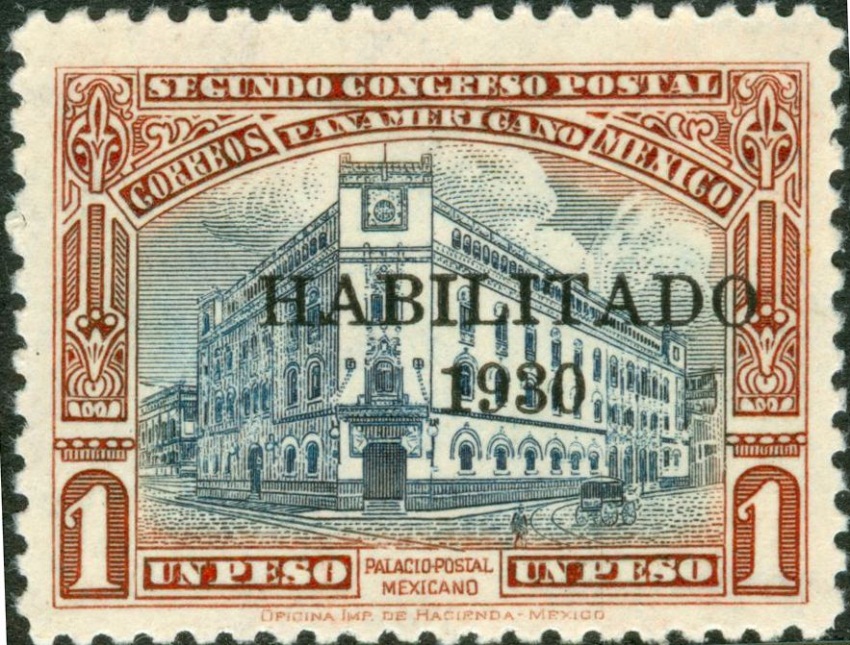 ]
]